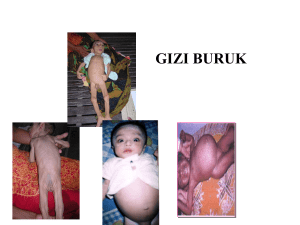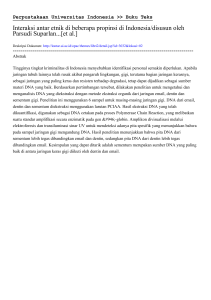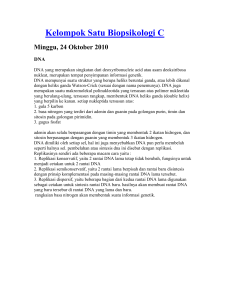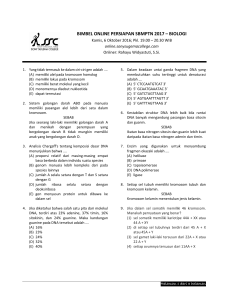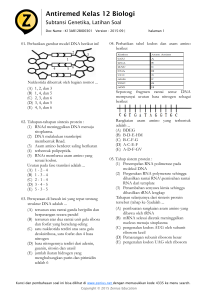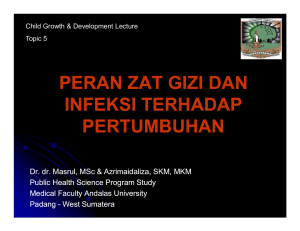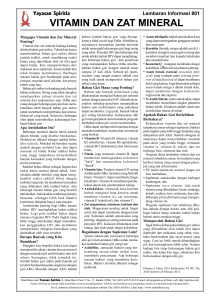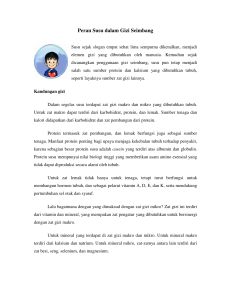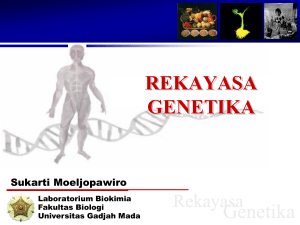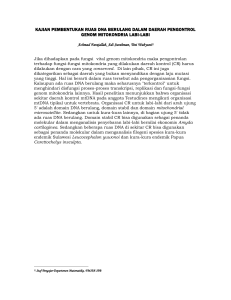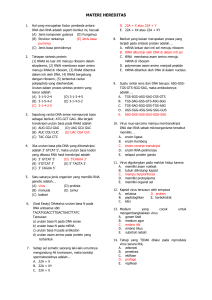KFI Newsletter
advertisement
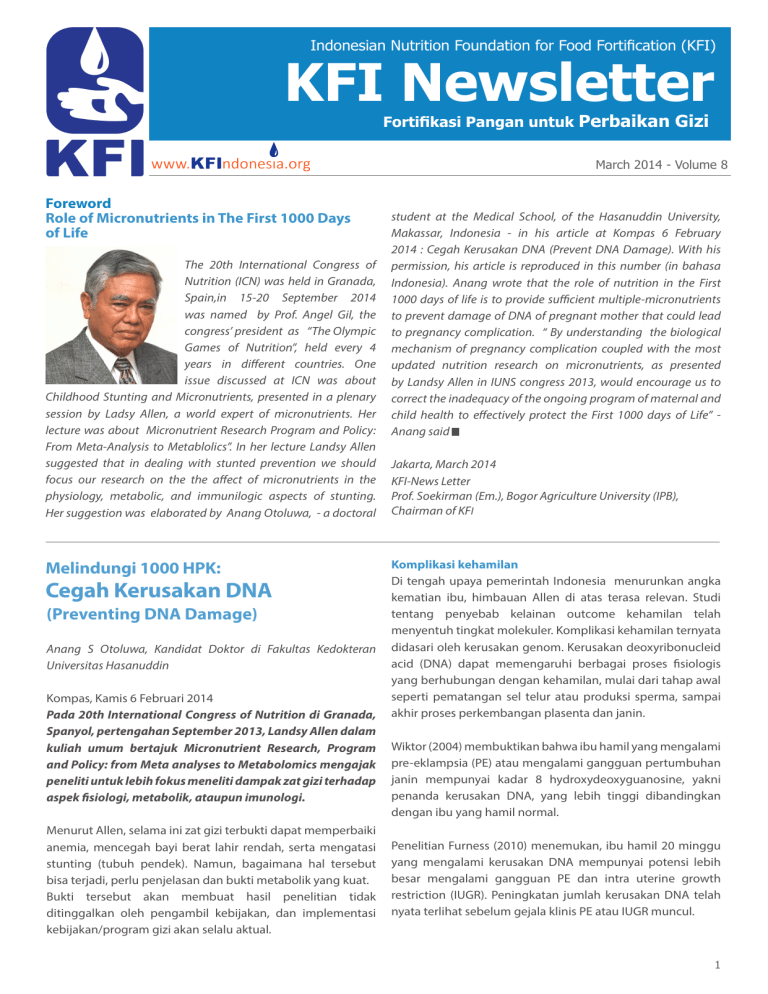
Indonesian Nutrition Foundation for Food Fortification (KFI) KFI Newsletter Fortifikasi Pangan untuk Perbaikan Gizi March 2014 - Volume 8 Foreword Role of Micronutrients in The First 1000 Days of Life The 20th International Congress of Nutrition (ICN) was held in Granada, Spain,in 15-20 September 2014 was named by Prof. Angel Gil, the congress’ president as “The Olympic Games of Nutrition”, held every 4 years in different countries. One issue discussed at ICN was about Childhood Stunting and Micronutrients, presented in a plenary session by Ladsy Allen, a world expert of micronutrients. Her lecture was about Micronutrient Research Program and Policy: From Meta-Analysis to Metablolics”. In her lecture Landsy Allen suggested that in dealing with stunted prevention we should focus our research on the the affect of micronutrients in the physiology, metabolic, and immunilogic aspects of stunting. Her suggestion was elaborated by Anang Otoluwa, - a doctoral Melindungi 1000 HPK: Cegah Kerusakan DNA (Preventing DNA Damage) Anang S Otoluwa, Kandidat Doktor di Fakultas Kedokteran Universitas Hasanuddin Kompas, Kamis 6 Februari 2014 Pada 20th International Congress of Nutrition di Granada, Spanyol, pertengahan September 2013, Landsy Allen dalam kuliah umum bertajuk Micronutrient Research, Program and Policy: from Meta analyses to Metabolomics mengajak peneliti untuk lebih fokus meneliti dampak zat gizi terhadap aspek fisiologi, metabolik, ataupun imunologi. Menurut Allen, selama ini zat gizi terbukti dapat memperbaiki anemia, mencegah bayi berat lahir rendah, serta mengatasi stunting (tubuh pendek). Namun, bagaimana hal tersebut bisa terjadi, perlu penjelasan dan bukti metabolik yang kuat. Bukti tersebut akan membuat hasil penelitian tidak ditinggalkan oleh pengambil kebijakan, dan implementasi kebijakan/program gizi akan selalu aktual. student at the Medical School, of the Hasanuddin University, Makassar, Indonesia - in his article at Kompas 6 February 2014 : Cegah Kerusakan DNA (Prevent DNA Damage). With his permission, his article is reproduced in this number (in bahasa Indonesia). Anang wrote that the role of nutrition in the First 1000 days of life is to provide sufficient multiple-micronutrients to prevent damage of DNA of pregnant mother that could lead to pregnancy complication. “ By understanding the biological mechanism of pregnancy complication coupled with the most updated nutrition research on micronutrients, as presented by Landsy Allen in IUNS congress 2013, would encourage us to correct the inadequacy of the ongoing program of maternal and child health to effectively protect the First 1000 days of Life” Anang said Jakarta, March 2014 KFI-News Letter Prof. Soekirman (Em.), Bogor Agriculture University (IPB), Chairman of KFI Komplikasi kehamilan Di tengah upaya pemerintah Indonesia menurunkan angka kematian ibu, himbauan Allen di atas terasa relevan. Studi tentang penyebab kelainan outcome kehamilan telah menyentuh tingkat molekuler. Komplikasi kehamilan ternyata didasari oleh kerusakan genom. Kerusakan deoxyribonucleid acid (DNA) dapat memengaruhi berbagai proses fisiologis yang berhubungan dengan kehamilan, mulai dari tahap awal seperti pematangan sel telur atau produksi sperma, sampai akhir proses perkembangan plasenta dan janin. Wiktor (2004) membuktikan bahwa ibu hamil yang mengalami pre-eklampsia (PE) atau mengalami gangguan pertumbuhan janin mempunyai kadar 8 hydroxydeoxyguanosine, yakni penanda kerusakan DNA, yang lebih tinggi dibandingkan dengan ibu yang hamil normal. Penelitian Furness (2010) menemukan, ibu hamil 20 minggu yang mengalami kerusakan DNA mempunyai potensi lebih besar mengalami gangguan PE dan intra uterine growth restriction (IUGR). Peningkatan jumlah kerusakan DNA telah nyata terlihat sebelum gejala klinis PE atau IUGR muncul. 1 KFI NewsLetter March 2014 - Volume 8 Peran zat gizi mikro Bagaimana kerusakan DNA dapat memengaruhi kejadian komplikasi kehamilan diduga berkaitan dengan iskemia (keadaan kekurangan darah dalam jaringan) atau hipoksia plasenta. Kerusakan DNA pada ibu hamil dapat menyebabkan terhambatnya pembelahan sel, perlambatan siklus sel, serta kematian sel (apoptosis) berlebihan yang menyebabkan gangguan invasi sel trofoblas pada saat pembentukan arteri spiralis.Padahal, invasi trofoblas diperlukan untuk membantu memperlebar arteri spiralis yang berperan mengirimkan darah ke plasenta. Jika arteri spiralis tidak terbentuk secara optimal, pasokan oksigen dan zat gizi akan terganggu, serta inilah yang menyebabkan komplikasi seperti PE dan IUGR. Peran zat gizi mikro Zat gizi mikro, yakni vitamin dan mineral, sangat penting untuk menjaga keutuhan DNA karena perannya sebagai kofaktor enzim pada sintesis (pembentukan) dan perbaikan DNA, pencegahan kerusakan DNA akibat oksidasi, serta memelihara proses metilasi DNA. Setiap zat gizi mikro dibutuhkan dalam jumlah yang cukup untuk mencapai hasil metabolisme maksimal. Kekurangan zat gizi mikro akan mengganggu metabolisme normal dan pada akhirnya akan menyebabkan kerusakan DNA. Hubungan antara kerusakan DNA dan defisiensi zat gizi mikro telah terbukti melalui berbagai studi. Kekurangan zat besi, magnesium, seng, vitamin B6, vitamin C, asam folat, dan biotin, menyebabkan peningkatan kerusakan DNA. Kerusakan DNA dapat terjadi jika kita mengalami kekurangan zat besi, seng, folat, vitamin B12, dan kolin, meskipun dalam jumlah sedikit. Adapun untuk selenium, tembaga, kalsium, niasin, dan kolin, kerusakan DNA terjadi jika tubuh mengalami defisiensi berat. Kekurangan seng diketahui dapat menyebabkan peningkatan pro-oksidan yang akan menyebabkan putusnya rantai DNA (single-strand breaks). Selain berperan dalam sintesis DNA, zat gizi mikro mempunyai peran sebagai kofaktor dalam perbaikan kerusakan DNA. Tugas ini dilakukan oleh seng dan magnesium sebagai kofaktor untuk polymerase DNA. Kekurangan seng dan magnesium menyebabkan kegagalan pada perbaikan double strand breaks DNA yang kemudian bisa berakibat putusnya kromosom. Pemberian zat gizi mikro telah terbukti dapat mengurangi kerusakan DNA. Thomas P (2011) dalam sebuah kajian melaporkan bahwa suplementasi vitamin antioksidan dan vitamin B dapat menurunkan kerusakan DNA. Studi lain menemukan bahwa kerusakan DNA secara signifikan berhubungan dengan kekurangan kadar vitamin B12 dalam serum (Fenech, 1998). Smolkova (2004) melaporkan, suplementasi dengan antioksidan mempunyai efek yang signifikan dalam mengurangi kerusakan DNA sejumlah 39 persen. 2 DNA sangat sensitif terhadap kekurangan zat gizi mikro. Kekurangan seng dalam 6 minggu menyebabkan peningkatan DNA strand breaks. Kerusakan DNA yang ditimbulkan oleh kekurangan asam folat dan B12 sama besarnya, bahkan lebih besar, dibandingkan dengan tingkat kerusakan DNA akibat paparan bahan kimia, radiasi ultraviolet, atau radiasi ion. Penurunan konsentrasi asam folat yang masih dalam batas fisiologis dapat menginduksi tingkat kerusakan DNA yang setara dengan yang ditimbulkan oleh paparan radiasi sinar X. Jika defisiensi ringan untuk satu jenis zat gizi mikro saja dapat menyebabkan kerusakan DNA yang hebat, bisa dibayangkan kerusakan yang timbul akibat kekurangan multizat gizi mikro. Implikasi program Dari hasil-hasil penelitian di atas tampak bahwa multizat gizi mikro sangat dibutuhkan oleh ibu hamil untuk mencegah kerusakan DNA yang pada akhirnya diharapkan dapat mencegah komplikasi kehamilan/persalinan. Kebutuhan itu tidak terbatas pada zat besi (Fe) atau asam folat saja sehingga pemberian tablet tambah darah tidak cukup. Hasil penelitian di Lombok (2008) membuktikan, suplemen multizat gizi mikro lebih efektif dalam menurunkan kejadian komplikasi kehamilan seperti abortus dan kelahiran mati, dibandingkan tablet tambah darah. Selain itu, terungkap bahwa ibu hamil anemia di negara-negara berkembang mengalami kekurangan bukan hanya zat besi saja, melainkan zat gizi mikro lain. Karena itu, program pemberian tablet tambah darah sudah saatnya dikaji, dan perlu dipertimbangkan untuk diganti dengan multizat gizi mikro. Hal lain yang perlu dikaji adalah kapan saat yang tepat untuk memberikan suplemen. Secara nasional, tablet tambah darah diberikan kepada ibu hamil. Namun, efektivitasnya mulai KFI NewsLetter March 2014 - Volume 8 Micronutrient Research Program and Policy: From Meta-analyses to Metabolomics ICN Daily News IUNS 20th International Congress of Nutrition, Granada Exhibition and Congress Centre Prof. Landsy Allen at 20th IUNS Conggress, Granada 2013 diragukan karena hingga saat ini prevalensi anemia tetap tinggi. Demikian pula, jika suplemen ini dimaksudkan untuk memperbaiki kerusakan DNA, saat pemberian yang tepat adalah sebelum hamil karena kerusakan DNA telah terjadi pada 8 minggu kehamilan. Akan lebih tepat jika pemberian suplemen menjadi bagian dari pelayanan perempuan sebelum hamil (preconception care). Pemahaman yang baik tentang mekanisme biologis terjadinya komplikasi kehamilan/persalinan serta adanya hasil riset mutakhir di bidang gizi dapat membantu kita untuk berani melakukan koreksi terhadap program kesehatan ibu secara mendasar. Harapannya, pencegahan di sektor hulu akan terlaksana sesuai harapan guna mempercepat turunnya angka kematian ibu menjadi 102 per 100.000 kelahiran hidup pada 2015 Stunting: The Face of Poverty Sri Mulyani Indrawati Source: http://blogs.worldbank.org/voices/stunting-face-poverty Globally, 165 million children under age 5 suffer from chronic malnutrition – also known as stunting, or low height for age. Much of this damage happens in pregnancy and the first two years of a child’s life. It means a child has failed to develop in full and it is essentially irreversible – which means that the child will have little hope of ever achieving her full potential. What will it take to end child stunting? The good news is that we already have many of the answers. We know that it is not just about getting more food, but ensuring that mothers and young children get the right foods with the right vitamins and minerals at the right times during the critical growth window between pregnancy and age 2. The latest evidence published in The Lancet also tells us with greater certainty that the roots of child malnutrition can even be traced to the health and nutritional well-being of adolescent girls before pregnancy. The evidence tells us that malnutrition costs lives, perpetuates poverty, and slows economic growth. We now know that nearly half of all child deaths globally are attributed to malnutrition. I have seen in my own country, Indonesia, how stunting caused by malnutrition has diminished too many children’s futures before they even begin. Malnourished children are more likely to perform poorly in school and drop out earlier than their betternourished peers, limiting their future earnings. Data from Guatemala show that boys who had good nutrition before age 3 are earning nearly 50% more as adults, and girls had a greater likelihood of having an independent source of income and were less likely to live in poor households. We estimate the annual price tag of providing a set of 13 high-return direct interventions to prevent and treat undernutrition at approximately $12 billion per year, with an estimated $10.3 billion gap that needs to be filled from sources other than affected households. Malnutrition diminishes not only the futures of individuals, but also of nations. Recent estimates suggest that as much as 11% of gross national product in Africa and Asia is lost annually to the impact of malnutrition. To end extreme poverty and promote shared prosperity, the world must commit to end child stunting due to malnutrition. I will be joining leaders from around the world in London this week to focus on this critical challenge. At the World Bank Group, we plan to triple our support for maternal and early childhood nutrition programs in developing countries in 2013-14 to $600 million, up from $230 million in 2011-12. An estimated 90% of this new funding ($540 million) is from the International Development Association (IDA), the Bank’s fund for the poorest. During the past decade, from 2002-12, IDA helped at least 52 million vulnerable mothers and young children receive life-saving and life-changing nutrition services. Ending child stunting is a multi-sectoral challenge. Water and sanitation investments have a huge potential to improve nutrition outcomes. Today, about 1.1 billion people do not have access to safe drinking water, and about 2.6 billion – or half of the developing world – lack a simple but adequate latrine. Safety nets and cash3 KFI NewsLetter March 2014 - Volume 8 transfers conditioned on good nutrition behaviors also have improved nutrition outcomes in Mexico, and have the potential to do so in Africa and Asia. of all GAFSP projects explicitly address undernutrition. Food and nutrition security must go hand in hand. Global food prices are forecast to remain volatile at least until 2015. In the poorest countries, where people spend up to twothirds of their daily income on food, rising prices further threaten the nutrition of the most vulnerable, especially women and young children. 60% of the world’s hungry are women, and in the face of food price hikes, families substitute lower-quality foods along with reducing food intake overall. Empowering women is also key, by giving women increased control over income and household decision-making. According to the U.N. Food and Agriculture Organization, if women had equal access to the full suite of agricultural services including land, technology, financial services, and markets, it would reduce the number of hungry people in the world by 100 million to 150 million. Gender-sensitive business and government policies can also make a big difference in better nutrition – for example, maternity leave as well as child care that allows for continued breastfeeding when mothers return to work. Amid continuing global food price volatility, the Bank Group will review our agriculture activities with a view toward improving nutrition outcomes. We have already seen excellent progress through the Global Agriculture and Food Security Program (GAFSP), where more than half We know what it will take, and where the gaps remain. Ending childhood malnutrition and stunting is an issue of equity and of development effectiveness. We can, and must, end the scourge of stunting and ensure that every child – and every nation – can reach their full potential PRESS RELEASE (KFI, Ministry of Health, GAIN) months, who likely benefited through improved vitamin A intake of their mothers during pregnancy and breastfeeding. Vitamin A Fortification Of Cooking Oil Shows Improvement In Mothers And Children’s “After fortification, vitamin A content in breast milk of lactating Nutrition – Promising Results From West Java mothers increased by more than half. The research showed Jakarta, 28 February 2014 – Vitamin A deficiency remains a public health problem in Indonesia, especially in children and women, which periodic vitamin A supplementation and diet-based approaches have not resolved. However, a recent study has shown that fortification of cooking oil with vitamin A improved intakes amongst vulnerable populations without any increase in cooking oil consumption. A year-long study conducted amongst low income households in 24 villages in Tasikmalaya and Ciamis districts in West Java showed that consumption of fortified cooking oil resulted in improved vitamin A intakes among young women, lactating mothers, children 12-59 months as well as 5-9 years, bringing these target groups much closer to their daily required nutritional intake. The first survey was done in June 2011 just before fortification started and the second one was concluded a year later to compare changes of vitamin A levels among test groups. In all groups, vitamin A levels in blood were better in 2012 than in 2011. This impact also extended to infants 6-11 that across all groups, the prevalence of vitamin A deficiency fell markedly from 6-18 percent to 0.5-6 percent, a 67 percent to 96 percent reduction,” explained Prof. Soekirman, Executive Director of Indonesian Nutrition Foundation for Food Fortification (KFI) who conducted the research. “The research was carried out to support the Ministry of Industry policy in July 2012 on the voluntary fortification guidelines for unbranded palm cooking oil (SNI 7709:2012), which was based on a request from the Ministry of Health to increase health outcomes amongst Indonesian populations” said Ir. Doddy Izwardi, MA, Director of Community Nutrition (Bina Gizi ) of the Ministry of Health. “The results show that fortification of cooking oil with vitamin A is a viable non-intrusive way to increase vitamin A intakes, including amongst in the most vulnerable population, “said Ravi Menon, Global Alliance for Improved Nutrition (GAIN) Country Manager, which supported the endline survey Credits: Concept: Prof.(Em.) Soekirman Creative: Harimawan Latif Writing: Ifrad DDS Picture Editor: Habibie Yukezain Published By Indonesian Nutrition Foundation for Food Fortification (KFI), Address: KFI c/o Komplek Bappenas A1, Jl. Siaga Raya Pejaten, Jakarta 12510, Indonesia, Phone: +62 21 7987 130, Fax: +62 21 7918 1016, Website: www.kfindonesia.org, Email: [email protected] 4 The KFI Newsletter is part of KFI-GAIN project. Supported by: SAFO - GFP
